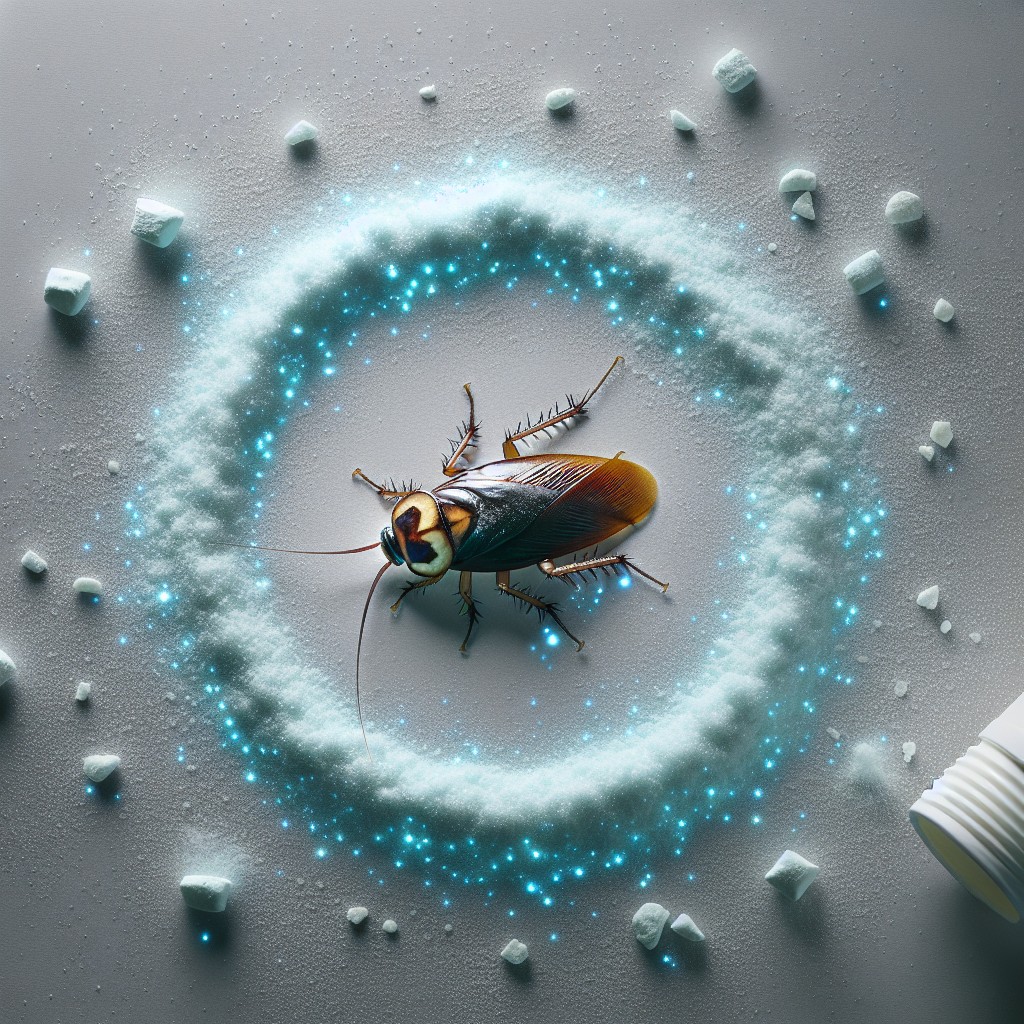Last updated on
Discover various methods to obliterate cockroach populations because not every solution is right for every infestation.
Key takeaways:
- Baking soda and sugar can be combined to create an effective cockroach poison.
- Boric acid is a widely used substance in roach eradication.
- Citrus or peppermint sprays can be used as natural repellents.
- Diatomaceous earth can be an effective natural strategy against cockroaches.
- Professional pest control services offer targeted and effective solutions.
Baking Soda

Harnessing the power of this common kitchen ingredient, you can create an effective cockroach poison. Combine equal parts of baking soda with a sweetener like sugar, which serves as the bait.
Roaches are attracted to the sweet taste, but upon consumption, the baking soda reacts with the acids in their stomachs producing gas. Since cockroaches cannot pass gas, this internal pressure can be fatal.
Sprinkle the mixture in areas where roach presence is frequent such as under sinks, behind appliances, and along baseboards. Replenish the bait regularly to maintain its potency and check the areas for signs of reduced roach activity over time.
Remember, while it’s a more natural solution, keep the mixture out of reach of pets and children to avoid accidental ingestion.
Boric Acid

Boric acid is a widely utilized substance in roach eradication due to its toxic effect on cockroaches’ digestive systems and exoskeletons. When applied correctly, it acts as a slow-acting poison that can effectively reduce the roach population over time.
Here’s how to use it:
- Apply a thin layer: Sprinkle a fine coating in areas where roaches are frequent, such as under sinks, behind appliances, and along baseboards. A heavy application can be less effective as roaches may avoid it.
- Combine with bait: Mix boric acid with attractants like powdered sugar or flour to entice roaches to consume the poison.
- Reapply as necessary: Maintain effectiveness by reapplying after cleaning or any time the powder is no longer visible.
- Avoid wet areas: Since boric acid loses its potency when wet, apply only in dry locations.
- Keep it out of reach: Ensure that children and pets don’t have access to areas where boric acid is applied, as it can be harmful if ingested.
Citrus or Peppermint Sprays
Harness the repellent power of natural scents to maintain a roach-free environment. Cockroaches dislike the smell of citrus and peppermint, which makes these oils effective deterrents.
You can create your own spray by mixing a few drops of citrus or peppermint essential oil with water in a spray bottle. Spritz the solution along baseboards, in corners, and behind appliances where cockroaches might lurk.
This approach not only leaves your home smelling fresh but also leverages non-toxic ingredients, ensuring the safety of both pets and family members. Moreover, frequent application will reinforce the repellent effect, reducing the likelihood of cockroach activity in treated areas.
Remember, this method serves as a preventive measure and might be less effective against an existing heavy infestation, which could require more aggressive treatments.
Diatomaceous Earth
Harnessing the abrasive power of diatomaceous earth (DE) can be an effective natural strategy in your battle against cockroaches. Derived from the fossilized remains of tiny, aquatic organisms known as diatoms, this fine powder spells doom for these pests. Here’s why:
- The microscopic edges of DE can pierce the exoskeletons of cockroaches upon contact.
- Once their armor is compromised, the pests dehydrate and die.
- DE works without chemicals, making it safer for use around the home compared to some traditional pesticides.
To use DE effectively:
- Purchase “food-grade” diatomaceous earth to ensure safety for humans and pets.
- Apply a thin layer of DE to areas where roaches are likely to frequent—think under appliances, along baseboards, and near trash areas.
- Avoid using it in wet areas, as moisture diminishes its effectiveness.
- Regularly replenish the powder, as traffic through treated areas will reduce its presence over time.
Remember, while DE is non-toxic, it can irritate lungs if inhaled in large quantities, so use with care and consider wearing a mask during application.
Professional Cockroach Services
When home remedies fall short, professional pest control services offer targeted and often more effective solutions. These experts employ a multifaceted approach to cockroach eradication:
1. Assessment: Technicians conduct a thorough inspection to determine the extent of the infestation and identify cockroach species, which can influence treatment strategy.
2. Treatment Plan: A customized plan is tailored to your home’s specific needs, leveraging industry-grade insecticides, gel baits, and growth regulators that are less accessible to the general public.
3. Application: Professionals apply treatments with precision to minimize exposure to pets and humans while maximizing impact on cockroaches.
4. Follow-Up: Reassessment and additional treatments ensure that the infestation is completely resolved and helps prevent future occurrences.
5. Education: Experts provide guidance on maintenance and prevention tips to keep cockroaches at bay after the treatment is complete.
By choosing professional services, you gain access to their knowledge of cockroach behavior and advanced eradication techniques, ensuring a more definitive solution to the problem.
Keep the House Clean
Maintaining cleanliness is a crucial step in deterring cockroach infestations. Regularly vacuum and sweep to remove crumbs and debris that can attract these pests.
Ensuring dishes are washed and put away promptly eliminates potential food sources. Store food, including pet food, in sealed containers and avoid leaving it out overnight.
Empty trash cans frequently, using bins with tight-fitting lids. Also, clear clutter where roaches could hide, like stacks of newspapers or cardboard boxes.
Remember, a tidy house is less inviting for cockroach exploration and colonization.
Fix Leaks and Moist Areas
Cockroaches are attracted to moisture, making damp areas prime real estate for these pests. To make your home less inviting:
- Regularly inspect under sinks, refrigerators, and dishwashers for moisture and promptly repair any leaks.
- Use a dehumidifier in damp basements or crawl spaces to reduce overall humidity levels.
- Check for sweating pipes and wrap them with insulation to prevent condensation.
- Ensure all areas around the home, such as bathrooms and kitchens, are properly ventilated.
- Wipe down shower stalls, bathtubs, and sinks after use to minimize standing water.
- Clear out gutters and downspouts to prevent water from pooling near your home’s foundation.
These steps help create a drier environment that is less appealing to cockroaches and can significantly reduce the likelihood of an infestation.
Keep the Landscaping Trimmed Back
Maintaining a well-groomed yard is more than just curb appeal—it’s a defense tactic against cockroach invasions. Overgrown bushes, stacked wood, and leaf litter create ideal shelters for these pests, so regular trimming is essential.
Here’s how to use landscaping to your advantage:
- Trim bushes and trees away from your home to eliminate cockroach bridges.
- Regularly rake up leaves, and clear away mulch from your foundation to remove hiding spots.
- Store firewood at least 20 feet away from your house to discourage transfer.
By ensuring your landscaping is neat, you remove the protective cover cockroaches seek and minimize the risk of infestation in your home.
Seal Gaps
Cockroaches can exploit the tiniest of spaces to invade your home. To effectively hinder their access, sealing potential entry points is essential.
Inspect both the interior and exterior of your property, focusing on areas like walls, floors, and ceilings for any cracks or crevices.
Use a sealant such as silicone caulk for smaller gaps around windows, doors, and where utility pipes enter your home.
For larger openings, consider applying expandable foam or installing mesh screens.
Don’t overlook less obvious entry points such as vents or drain pipes; for these areas, wire mesh or vent covers can be effective barriers.
Regular maintenance checks are important to ensure that previously sealed gaps have not deteriorated or become exposed over time.
By diligently sealing potential entrances, you can create a stronghold against cockroach invasions, maintaining a clean and pest-free environment.
What Smell Will Keep Cockroaches Away?
Certain fragrances work wonders in deterring cockroaches due to their intense dislike for strong scents. Essential oils such as eucalyptus, peppermint, and tea tree oils emit powerful odors that repel these pests.
Similarly, a mixture of lavender oil or lemongrass with water can be used to create a homemade spray that not only keeps the bugs at bay but also imparts a fresh, clean smell to your home.
Citrus fruits, especially lemon, are another natural deterrent; wiping surfaces with lemon juice or leaving peels out can discourage roach activity.
Additionally, crushed bay leaves and catnip have been identified as effective repellents; place them in problem areas as an eco-friendly solution to cockroach invasion.
Remember, while these scents may help to repel roaches, they should be used in conjunction with other preventative measures to ensure a roach-free environment.
What Attracts Cockroaches in Your Home?
Cockroaches gravitate towards environments where basic survival needs are met. Here are several elements that draw them to your living spaces:
- Food Scraps: Even the smallest crumb can be a feast for a cockroach, making unsealed food containers, crumbs on floors, and unwashed dishes prime targets.
- Moisture: These pests need water to thrive, making leaky pipes and damp areas hot spots for activity.
- Clutter: Cardboard boxes, piles of paper, and other stacked materials can provide shelter and nesting grounds for roaches.
- Darkness and Warmth: These nocturnal creatures prefer to operate unseen, seeking out warm, dark nooks and crannies that mimic their natural habitat.
- Garbage: Unsecured trash bins are an open invitation to cockroaches, offering an ample supply of food waste.
- Pet Food Bowls: Left-out pet food is an easy food source, attracting roaches to feeding areas during off hours.
Understanding these attraction points is crucial for implementing effective prevention strategies.
Safety Considerations
When embarking on a mission to eliminate cockroaches, personal and family safety must take precedence. Keep these pointers in mind:
- Read and follow pesticide labels carefully, ensuring you understand the application process and the recommended safety precautions.
- When using sprays or powders, wear protective gloves and masks to prevent skin contact or inhalation of potentially harmful substances.
- Keep any cockroach treatment products away from children and pets to avoid accidental ingestion or contact.
- Consider the environmental impact of the substances you use, opting for greener solutions when possible to reduce your ecological footprint.
- Ventilate the area well if you’re using any chemical sprays or foggers, as these can linger and may be harmful if inhaled over time.
- Store food away and cover kitchen utensils or equipment during treatment to prevent contamination.
- If someone in the home has a respiratory condition, be extra cautious with aerosol sprays and consider alternative methods.
- In case of accidental poisoning, keep emergency numbers handy and know the first aid response.
Identify the Roach
Recognizing the roach species infesting your space is crucial for effective eradication. Different species have varied preferences and habits. For instance, German cockroaches thrive indoors, often in kitchens and bathrooms, while American cockroaches are more common in basements and sewers.
- German cockroaches are small and light brown, with two dark stripes on their back.
- American cockroaches are larger, reddish-brown, and have a yellow figure eight pattern on the back of their heads.
- Oriental cockroaches are dark brown to black and prefer damp areas.
- Brown-banded cockroaches are brown with lighter bands across their wings.
Understanding the type determines the most effective treatment methods, as some baits or traps may work better for certain species. It also guides where to focus control efforts since each species congregates in different areas of a home or building.
Locate Their Harborage Areas
Uncovering the hiding spots of cockroaches is crucial in mounting an effective assault against these pests. Focus your search in warm, dark, and moist areas, as these conditions are highly attractive to cockroaches. Common hideouts include underneath sinks, behind refrigerators and stoves, near garbage containers, inside cracks and crevices, and around water heaters.
In addition, inspect cardboard boxes, pantry corners, and anywhere clutter accumulates, providing them with perfect cover.
To ensure a thorough investigation, use a flashlight and check during the night when these nocturnal critters are most active. Pay attention to droppings, egg cases, and a musty odor, as these are telltale signs of an infestation nearby. By identifying these zones, you can target your control methods more precisely, reducing the roach population more effectively.
Remember, the key is not just to find where they are, but to understand why they are there—addressing moisture, warmth, and food sources will make these areas less inviting.
Clean Up and Remove Roach Habitat and Food Sources
To combat cockroach infestations effectively, focus on denying them what they thrive on: food and shelter. Even crumbs and spills are banquets for these pests, so regular vacuuming and wiping surfaces are crucial.
Store food in airtight containers and avoid leaving pet food out overnight.
Take out the trash consistently and make sure all bins have tight-fitting lids.
Clutter provides the perfect hiding spots, so declutter regularly, paying special attention to stacks of papers, laundry piles, and cardboard boxes.
Finally, inspect your home for excess moisture, as damp environments are cockroach magnets. Repair leaky faucets and ensure areas under the sink are dry.
These are practical steps toward creating an inhospitable environment for cockroaches, driving them to look elsewhere for sustenance and shelter.
Deploy Roach Treatment
Once you’ve identified the infested areas, it’s time to take action. Gel baits are highly effective; apply in small dots along crevices where roaches travel. Roaches ingest the bait and return to their hiding places, where they die and are consumed by other roaches, further spreading the poison.
For broader application, insecticide sprays can be used along baseboards, under appliances, and in corners. Aim for a light misting; too much can cause roaches to scatter and spread the infestation. Always follow the product’s directions for safe use.
Insect growth regulators (IGRs) are another savvy choice; they interrupt the roach life cycle, preventing reproduction. These can be used in tandem with baits and sprays for a more integrated approach.
For those seeking a non-toxic method, diatomaceous earth can be sprinkled in dry areas where roaches are likely to pass. This fine powder is harmless to humans but lethal to roaches, piercing their exoskeletons and causing dehydration.
No matter which treatment you choose, patience is key. It may take several days to weeks to see significant results, and repeat treatments are often necessary to fully eradicate the problem. Regular monitoring of roach activity will guide your ongoing treatment efforts.
Prevent Roaches From Getting in
To ensure your home becomes a no-entry zone for cockroaches, focus on these key preventive measures:
- Sealing cracks and crevices is imperative. Use caulk to seal gaps in walls, floors, and ceilings, around bathroom fixtures, and where pipes penetrate walls.
- Window screens and door sweeps are your first line of defense. Install fine mesh screens on windows and apply door sweeps to block entry points.
- Manage waste effectively. Keep garbage in sealed containers and dispose of it regularly.
- Don’t provide a buffet. Store food in airtight containers and avoid leaving pet food out overnight.
- Reduce moisture. Fix leaky faucets and pipes, use dehumidifiers, and ensure your home has adequate ventilation to discourage roach habitation.
By addressing these potential vulnerabilities, you can significantly decrease the likelihood of a cockroach infestation.
How Do Exterminators Deal With Roaches?
Exterminators follow a systematic approach to ensure a cockroach-free environment.
The Inspection
Professionals start with a thorough evaluation, spotting signs of infestation such as droppings, egg cases, and shed skins. Inspecting common hideouts like kitchens, bathrooms, and basements is crucial for a successful strategy.
The First Treatment
Based on the inspection, exterminators choose treatments like gels, baits, or insect growth regulators to target the roaches effectively. They apply these treatments in strategic locations to disrupt the life cycle and reduce the population.
Follow-Up
Subsequent visits are often necessary. During these, exterminators monitor the situation, reapply treatments if needed, and adjust their approach based on the progress. The objective is to entirely eradicate the infestation and prevent a recurrence.
Throughout the process, safety measures are taken to protect residents and pets. Professional pest control often yields faster, more effective results than DIY methods, due to the expertise and powerful tools at their disposal.
The Inspection
Once an exterminator arrives, they embark on a meticulous search through your home, scrutinizing common roach hideouts such as kitchens, bathrooms, and basements. They’re not just hunting for live insects; they’re also on the lookout for droppings, egg casings, and shed skins. These signs help determine the species, which is vital because different types of cockroaches may require different treatments.
Taking note of where these indicators are most concentrated allows the exterminator to gauge the infestation’s severity and pinpoint the primary harborages to be targeted during treatment. Knowing the level of infestation and species involved enables the formulation of a more effective and personalized eradication strategy.
The First Treatment
Upon commencing treatment, exterminators strategically apply insecticide in various forms—gels, baits, powders, or sprays—targeting frequented roach pathways and nesting sites.
Gels and baits are especially potent, as they exploit the roaches’ scavenging habits, enticing them with a lethal meal.
These options are preferred since surviving roaches consume the carcasses and droppings of the poisoned, spreading the effect.
Treatment may further extend to cracks and crevices, under appliances, and along baseboards, ensuring no stone is left unturned.
Occupants are generally advised to avoid the treated areas until the insecticide has dried, prioritizing safety while ensuring the treatment’s effectiveness.
Recap




